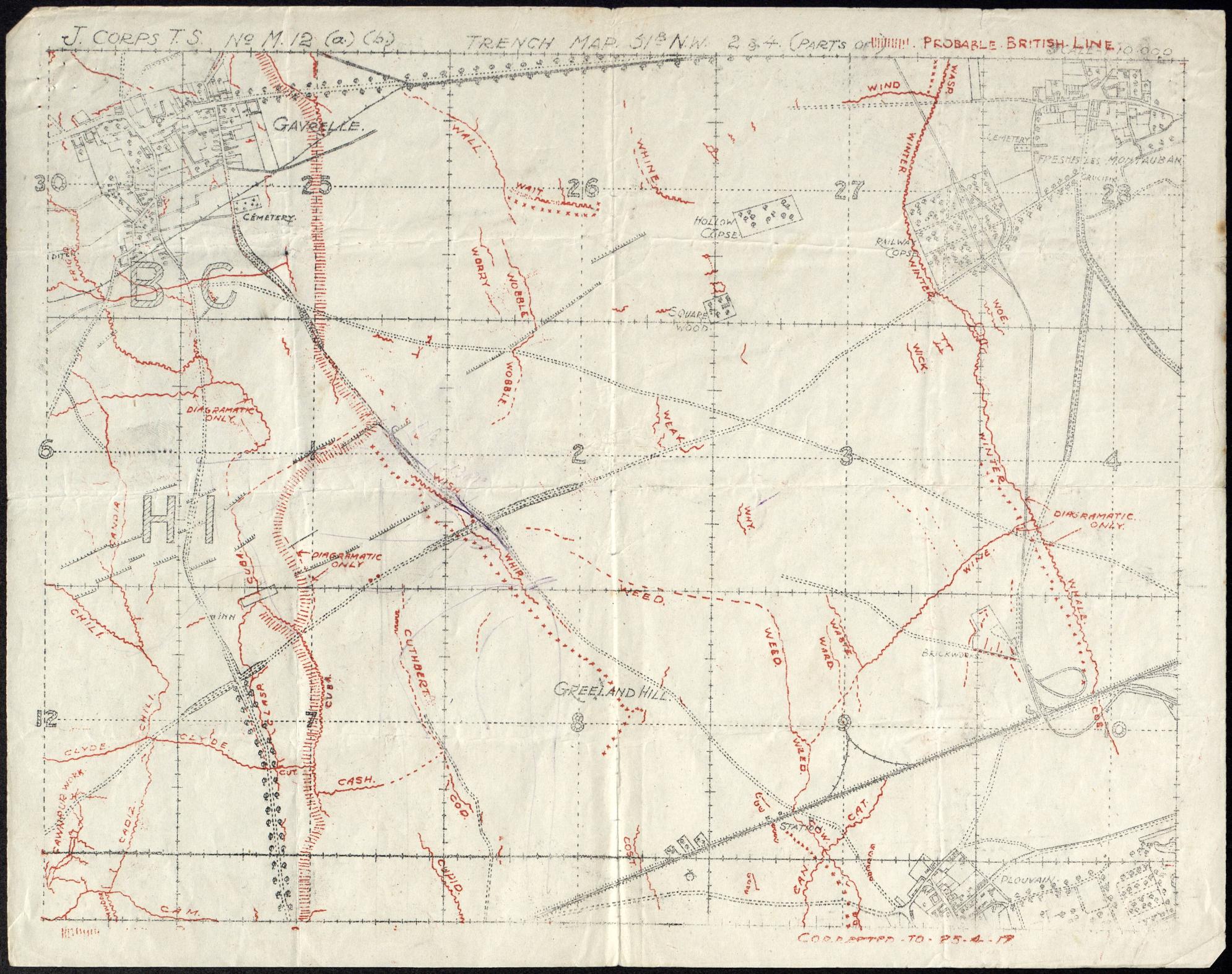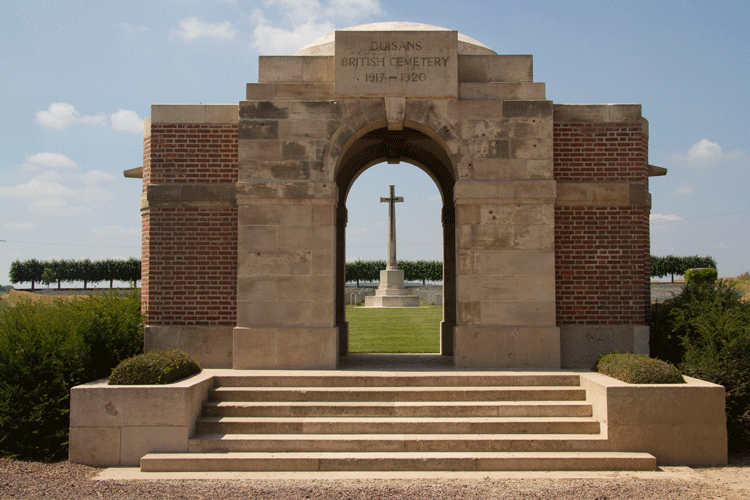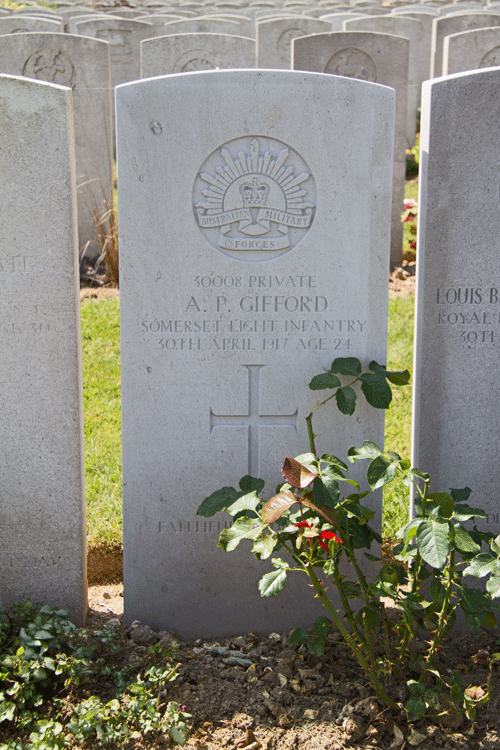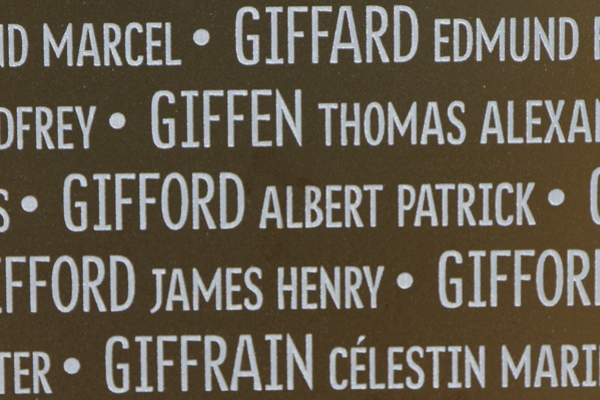Albert Patrick Gifford
Family
Albert Patrick Gifford was born in Dartmouth in 1892 and baptised at St Saviours on 18th August 1892. He was the eighth of twelve children of Frederick Filmer Gifford and his wife, Emily Dinah Ford Burdett.
Neither of his parents were natives of Dartmouth. Frederick Gifford was born in Ickham, Kent. He was apprenticed into the merchant service in Whitstable, in 1872. Merchant Navy Crew Lists show that by 1876, he was working on a ship owned by the Redway family, of Dartmouth.
In Dartmouth he met Emily Burdett, the daughter of John Burdett, a plasterer, and his wife, Emily Ford. John came from Totnes and his wife from Plymouth. Emily Dinah was their only surviving child; they had suffered the loss of four others, two of their children, Esther Ellen, aged 6, and Esther Selina, aged 3 months, being buried on the same day in 1863. Emily Burdett (senior) herself died only a few months later and was buried with her children in Ford Park Cemetery, Plymouth, in 1864. It seems that, after these family losses, John wanted a new start, and so brought his daughter Emily to live in Dartmouth. At the time of the 1871 Census, they lived in Clarence Hill.
On 14th August 1877, Frederick and Emily married at St Clements, Townstal. Sadly their first son, John Frederick Filmer, died aged only seven weeks, on 12th March 1878. By the time of the 1881 Census, however, the couple had another child, Emily Rosina, born on 8th July 1879. On the night of the Census, Frederick was away from Dartmouth, being recorded as a member of the crew of the cargo ship Fawn, in Portland. The Fawn's Master was Arthur Langley, with whom Frederick worked on other ships too. In Dartmouth, Emily was recorded in Higher Street, with little Emily, aged one, and her father, John Burdett - who continued to live with the couple until he died in 1904.
Frederick and Emily's family grew steadily - after Emily Rosina, in 1879, St Saviour's baptism records show five children during the next ten years - Lily Esther, in 1882; James Frederick, 1884; Alfred George, 1885; Ethel Maude, 1888; and Ernest William, in 1890. At the time of the 1891 Census, the family was living in Zions Slip (now Zion Place). Frederick continued to work as a sailor in the merchant service. Albert Patrick was born in Zions Slip in 1892. A sister, Ellen Selina, named it would seem for Emily's two sisters who had been buried together, followed in 1895 - but perhaps her naming was a bad omen, for she died aged only five months. Edith Anne was born in 1896, and Edward Filmer in 1899 - sadly, he too died young, aged four months.
Frederick and Emily's last child, George Henry, was born in 1901. By this time, Frederick had found work ashore in Dartmouth as a coal-lumper and labourer. The 1901 Census recorded the family in Lower Street. Emily Rosina no longer lived at home - she married shortly after the Census; no occupation was shown for Lily, who no doubt assisted her mother in looking after the family. James and Alfred had begun their working lives - James as a baker, and Alfred as an errand boy. Ethel, Ernest, Albert, and Edith were all at school.
In 1911, Frederick and Emily were still living in Lower Street with their four youngest children. Ernest worked as a boot repairer and Albert for one of Dartmouth's butchers. No occupation was shown for Edith (known as Annie) and George, the baby of the family, was still at school.
It seems that at some time between 1911 and the outbreak of war Albert joined the Works Department of the Royal Naval College (see below). Several members of his family, including his brother James and two of his brothers-in-law - Ernest Adams and Edward Hughes - already worked at the College as civilian domestic staff.
Service
Albert's Army service records have not survived. However, both he and his elder brother Ernest appear as members of 7th Battalion Devonshire Regiment (Cyclists), in a list of those serving in HM Forces, published in the Dartmouth Chronicle on 16th October 1914 (lists of those already serving and who had volunteered were published weekly from soon after the start of the war until conscription was introduced in 1916). Soldiers Died in the Great War shows that Albert's Devon Regiment number was 1169.
Several of the men on our database began their Army service with the Devon Cyclists, including Frederick George Coles, whose Devon Regiment service number was 1076 and whose records show that he attested on 7th August 1914. Another Dartmouth man, Frederick James Blank, who survived the war and whose service papers also survived, enlisted with the Devon Regiment Cyclists on 15th October 1914, and received the service number 1317. This suggests that Albert was not a member of the Devon Cyclists before the war, but joined up soon after the war began, perhaps around September 1914.
For the early service of the Devon Cyclists, see the stories of Harold Montague Mandley, who was mobilised at the outbreak of war, and Frederick Bell, who joined up at about the same time as Albert, but died early in 1915.
As part of the Territorial Force, which had been created for the purpose of home defence, members of 7th Devons had no liability to service overseas. Their role was coastal and home defence, and assistance to the civil powers as necessary. Many in any case volunteered to go abroad; and with the coming of conscription in 1916, the limitation on Territorials' liability was removed. The 7th Devons, as such, never left England, but many of its members transferred to front-line units. Many, including Harold Mandley, transferred to the Army Cyclist Corps; a large contingent transferred to the 2nd/8th Worcesters - including Frederick Coles, referred to above, Joe Henley and Patrick Lyons.
Our research has also shown that several of the men on our database were part of another large contingent of Cyclists who transferred to the Somerset Light Infantry, including Albert, James Moriarty, and Samuel Bickford. Albert's brother Ernest also appears to have transferred at the same time. The draft of 100 Cyclists embarked from Southampton on 26th July 1916, landed at Rouen the following day, and joined 8th Battalion Somerset Light Infantry in the field on 6th August 1916, "on attachment". They formally transferred to the Somerset Light Infantry Regiment as from 30th August 1916, and were allotted new service numbers.
When the Devon Cyclists joined, the 8th Somersets, having been part of the attack on the first day of the Battle of the Somme, had been transferred to the sector between Arras and Lens, near Souchez - at that time, quiet. They returned to the Somme towards the end of October, and fought at the very last phase of the Battle of the Ancre. In February 1917, they moved north again, taking over trenches near Loos, and then on 9th April 1917, were brought into the Battle of Arras, moving up behind the initial attack to consolidate the gains made on the first successful day. For the background to the Battle of Arras, and a brief account of the opening day, see the story of Cyril Stafford.
For the Somersets' experiences up to and including their involvement in the phase of the Battle of Arras known as the "Second Battle of the Scarpe", on 23rd April 1917, see the story of James Moriarty, already referred to, later presumed to have been killed on that day.
The Battle of Arleux
On 28th April 1917, the Somersets, as part of 37th Division, were brought again into the continuing action around Arras, in the same sector of the front, to the north of Roeux and the River Scarpe. The total front over which action took place on that day was about eight miles - it has come to be known as the "Battle of Arleux", although Arleux itself (a village further to the north) was the objective of 1st Canadian Division. The attack of XVII Corps was carried out by 34th Division on the right and 37th Division on the left.
After the action on 23rd April, the Somersets had been reduced to a fighting strength of about 200 or so, and so for the attack were divided into four platoons of 50 men. Their objective was to continue the attack forward over the same area as they had fought five days earlier, to take "Wish" and "Whip" trenches, which ran close to the road between Plouvain and Gavrelle, and from there, a position defined as a [notional] north-south line from Whip trench to the Divisional boundary on the right. The area over which the attack took place is shown on the trench map below; today, much of the area over which they advanced is occupied by the intersection of the A1 and A26 autoroutes - the A1 running north diagonally bisects the area.

On the night of 27th/28th April, the Battalion moved forward from Heron Trench, and took up position in Cuba Trench (which they had taken on 23rd April). Zero-hour was at 4.25. It was extremely dark and a hostile barrage as the attack went forward did not help. According to the Somersets War Diary, a small party was left in Cuthbert Trench, the first enemy trench to be reached, "to mop up and consolidate", while the main body headed for Whip Trench. Exactly what happened at this point is not clear; according to the War Diary:
Finding Whip Trench in front, the troops swung to the left to attack it. Finding no opposition, it was impossible to check their onward rush, which carried them in a north-easterly direction as far as Railway Copse.
In so doing, they had swung too far to the left from the intended objective of the "north-south line connecting Whip trench to the right hand Divisional boundary". They had also dangerously overreached themselves, going forward over a mile behind enemy lines, out of touch with neighbouring Brigades, at risk of German counter-attack, and in the zone targeted by British artillery.
According to the Somersets War Diary, "returning wounded reported that there was no opposition and they were confident the village of Fresnes [les-Montauban] could have been easily taken had there been a few more troops". But this seems unlikely, as the Official History's account of the action notes that many men were taken prisoner. It is also possible that many more were casualties of friendly fire. Certainly many men were reported missing who subsequently were regarded as having been killed on 28th April, amongst them Samuel Bickford.
The War Diary, however, states that:
Consolidation of Whip Trench was "at once proceeded with by the mixed collection of Somersets, Bedfords etc" including "many of those who swept on [but then] returned.
In the meantime, the small group in Cuthbert Trench, under 2nd Lt Cooksley, had been left isolated, apparently unable to move. The War Diary says that two companies of the Middlesex tried to reach them, but were prevented by machine gun fire. Eventually he "got in touch with the Seaforths in Cuba [Trench] and was relieved". The attack was called off at some stage in the afternoon.
The 8th Somersets War Diary shows officer casualties for 28th April as two killed, four wounded. Casualties for the men are given as a total for the period 20th-28th April, covering both the action on 23rd April and that on 28th:
| Killed: | 17 |
| Wounded: | 180 |
| Missing: | 99 |
Both Albert and Ernest were wounded during this period, Albert fatally; but because of the way the casualties were recorded, and in the absence of any other individual record, it is not possible to say whether they were wounded in the action on 23rd or that of 28th April.
Death
Albert appears to have reached 8th Casualty Clearing Station at Duisans, west of Arras, where the Somersets had been billetted the day before the first day of the Battle. He died there and was buried in Duisans British Cemetery.


His sister, Edith Annie, requested that his headstone bear the words "Faithful unto death". It is not clear why the headstone is engraved with the badge of the Australian Military Forces.
News reached Dartmouth quickly. In the edition of 11th May 1917, the paper reported in its "local intelligence" column:
Died of Wounds
Amongst the recent casualties to Dartmouth men at the front occur the names of Albert Patrick (Bert) Gifford, Somerset LI, son of Mr and Mrs Gifford, of Coombe Terrace Sandquay, and also Corpl Joseph Stuart Henley of the Devons, youngest son of Mr and Mrs J J Henley, Waterpool Road, both of whom we very much regret to hear have succumbed to wounds received in action.
(See Joe Henley's story.)
Frederick and Emily placed an announcement of Albert's death in the same edition of the paper:
Gifford: Died of wounds in France, Albert Patrick (Bert) Gifford, 8th Somerset Light Infantry, age 24, the dearly loved son of FF and E Gifford, 7 Coombe Terrace, Sandquay, Dartmouth.
Deeply mourned by all.
Ernest was evacuated to England and news of his treatment appeared in the paper the following week:
One son killed, another wounded
Pte E W Gifford, son of Mrs F F Gifford, of Coombe Terrace, Dartmouth, has been wounded, and one of his arms has been amputated in a London hospital. Last week Mr and Mrs Gifford received the sad news that their other son, Albert, had died of wounds. Both brothers were serving in the Somerset LI.
Ernest was discharged from the Army on 28th June 1918. He married earlier that year.
Commemoration
As one of the 579,206 casualties in the region of Nord-Pas-de-Calais, Albert is also commemorated on the new memorial at Notre Dame de Lorette, "The Ring of Memory".


In Dartmouth, Albert is commemorated on the Town War Memorial, the St Saviour's War Memorial Board, and the St Petrox War Memorial.


His name also appears on a "Roll of Honour" presented to the employees of the Works Department of the Royal Naval College, by W. Grey, Foreman of Works 1899-1919, showing those who had served in the Great War. The Roll of Honour is now in Dartmouth Museum. See also Harold Claude Shattock.
Sources
The War Diary of the 8th Battalion Somerset Light Infantry, 1916 August to 1919 April, is available from the National Archives, fee payable for download, reference WO 95/2529/2
The account of the Battle of Arleux also draws on information provided on the Great War Forum.
Information Held on Database
| Surname: | Gifford |
| Forenames: | Albert Patrick |
| Rank: | Private |
| Service Number: | 30008 |
| Military Unit: | 8th Bn Somerset Light Infantry |
| Date of Death: | 30 Apr 1917 |
| Age at Death: | 24 |
| Cause of Death: | Died of wounds |
| Action Resulting in Death: | Battle of Arras |
| Place of Death: | Duisans near Arras, France |
| Place of Burial: | Duisans British Cemetery, Etrun, France |
| Born or Lived in Dartmouth? | Yes |
| On Dartmouth War Memorial? | Yes |
| On St Saviour's Memorials? | Yes |
| On St Petrox Memorials? | Yes |
| On Flavel Church Memorials? | No |
| In Longcross Cemetery? | No |
| In St Clement's Churchyard? | No |
| On a Private Memorial? | No |
| On Another Memorial? | Yes |
| Name of Other Memorial: | "The Ring of Memory" at Notre Dame de Lorette |















